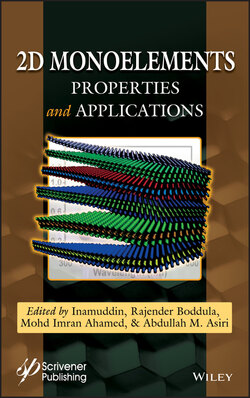Читать книгу 2D Monoelements - Группа авторов - Страница 47
2.3.2 Liquid Phase Exfoliation
ОглавлениеLiquid phase exfoliation (LPE) is the process of placing a bulk material into a liquid and peeling off large quantities of dispersed layers by the action of liquid molecules. According to the need for surfactants, LPE can be divided into two categories, i.e., surfactant-free and surfactant-assisted LPE [18]. Common liquids in the LPE include aqueous and organic solutions. This method is expected to realize the inexpensive production of large-scale 2D materials. Currently, monolayer and few-layer 2D materials have been successfully prepared by the LPE.
Gibaja et al. first reported the production of few-layer antimonene by surfactant-free LPE under sonication assistance [19]. Through several attempts, they obtained the best solvent for peeling off antimonene that is the 2-propanol/water mixture with volume ratio of 4:1. In addition to solvent selection, other factors such as sonication time, initial quantity of antimony crystals, and centrifugation conditions were also considered to optimize the LPE process. Ground antimony crystals in selected solvent were sonicated (400 W, 24 kHz) for 40 min, yielding a colorless dispersion with a Faraday-Tyndall effect (Figure 2.4a). After removing the unpeeled bulk materials by centrifugation (3,000 rpm) for 3 min, a stable-dispersion suspensions of micro-scale few-layer antimonene can be obtained with a concentration of ~1.74×10−3 gL−1. The surface topography of few-layer antimonene flakes was observed by AFM (Figure 2.4b), confirming the successful exfoliation of antimony crystals using the LPE method. Analyzing the step heights of these flakes in Figure 2.4c, multiples of which were about 4 nm without showing typical terrace characteristics. These antimonene flakes possessed well-defined structures and their lateral dimensions were greater than 1–3 μm2. From the high-angle annular dark field (HAADF) images of a typical antimonene flake in Figure 2.4d, it can be seen that the crystal structure conforms to β-antimonene and the flake is highly crystalline with no major defects. Figure 2.4e shows the Raman spectra of exfoliated antimonene flakes with different thicknesses, it is observed that the Raman intensity has a certain dependence on the thickness, where the peak intensity increases with the increase of the thickness, only for the flakes with thicknesses greater than 70 nm.
Figure 2.4 (a) Optical image of a dispersion of exfoliated few-layer antimonene. (b) AFM image of few-layer antimonene flakes drop-casted onto a SiO2/Si substrate. (c) Height histogram of the image in panel (b). (d) Low-magnification (top left) and an atomic-resolution (down right) HAADF images of a typical antimonene flake taken along the [0–12] direction. (e) Single-point spectra of different thicknesses were measured by studying AFM images (inset). The TEM (f) and HRTEM (g) images of exfoliated antimonene nanosheets. Raman spectra (h) and high-resolution XPS (i) of Sbbulk and SbSE. (a–e) Reproduced with permission [19]. Copyright 2016, Wiley-VCH. (f–i) Reproduced with permission [21]. Copyright 2017, Wiley-VCH.
It usually takes a long time for the sonication process in the LPE. If the sonication power is increased during the LPE or the antimony crystals are pretreated before the LPE, the exfoliation time will be greatly shortened and the yield can be remarkably improved [20, 21]. High sonication power affords sufficient energy to break the van der Waals interactions between the Sb-Sb layers, while the pre-grinding of antimony crystals provides a shear force along the Sb-layer surface, and both processes are conducive to peel off thin antimonene flakes. By using ultrahigh sonication power (850 W) in the surfactant-free LPE, high-quality and high-stability antimonene was prepared in the ice-bath with ethanol as the best solvent, and the exfoliated flakes possessed narrow thickness distribution (0.5–1.5 nm) [20]. The high specific capacity (860 mAh g–1) of antimonene made it very suitable for the anode of a sodium ion battery (SIB), and the antimonene anode exhibited good cycling stability and high rate capability. Moreover, adding pre-grinding of antimony crystals in the 2-butanol solvent before sonication, uniform and smooth antimonene flakes were produced by the modified LPE method [21]. The micron-scale antimonene flakes had tunable thicknesses between 0.5 nm and 7 nm, specifically, their band gaps were also finely tuned from 0.8 eV to 1.44 eV. The antimonene was served as a hole transport layer (HTL) in a perovskite solar cell, due to its matched energy level with CH3NH3PbI3. Comparing with the HTL-free device, both of the highest short-circuit current density (Jsc) and external quantum efficiency (EQE) of antimonene-HTL device were increased by 30%.
In addition to generating shear force via pre-grinding antimony crystals before the LPE, shear force can also be obtained in the process of LPE by using rotating blades mixers. Gusmão et al. obtained arsenene, antimonene, and bismuthene exfoliated nanosheets by the surfactant-assisted LPE method under the action of shear force generated by rotating household kitchen blenders [22]. As the transmission electron microscopy (TEM) shown in Figure 2.4f, the morphology of exfoliated antimonene (SbSE) nanosheets consisted of shapes with defined angles and nanostripes because the preferential cleavage of antimony crystals was easy to occur in different crystallographic directions. The size distribution of antimonene nanosheets exhibited a broad range from 100 nm to 900 nm and the maxima value appeared at around 200 nm. Then, the high-resolution TEM (HRTEM) was employed to determine the structure of antimonene (Figure 2.4g). The Raman intensity of SbSE was lower than that of bulk antimony (Sbbulk), and the Raman peak shifted to higher frequency owing to partial oxidation (Figure 2.4h). The bonding states of Sbbulk and SbSE were also investigated by the high-resolution X-ray photoelectron spectra (XPS), it can be seen that both the element phase (Sb 3d5/2, 3d3/2) and partial oxidation phase (Sb2O3) existed in the SbSE (Figure 2.4i). As a pnictogen, SbSE can be used for the electrochemical detection of ascorbic acid due to its high electron transfer properties and low onset oxidation potential. Also, SbSE can be considered as a wide-pH-range catalyst for the hydrogen evolution reaction (HER).
